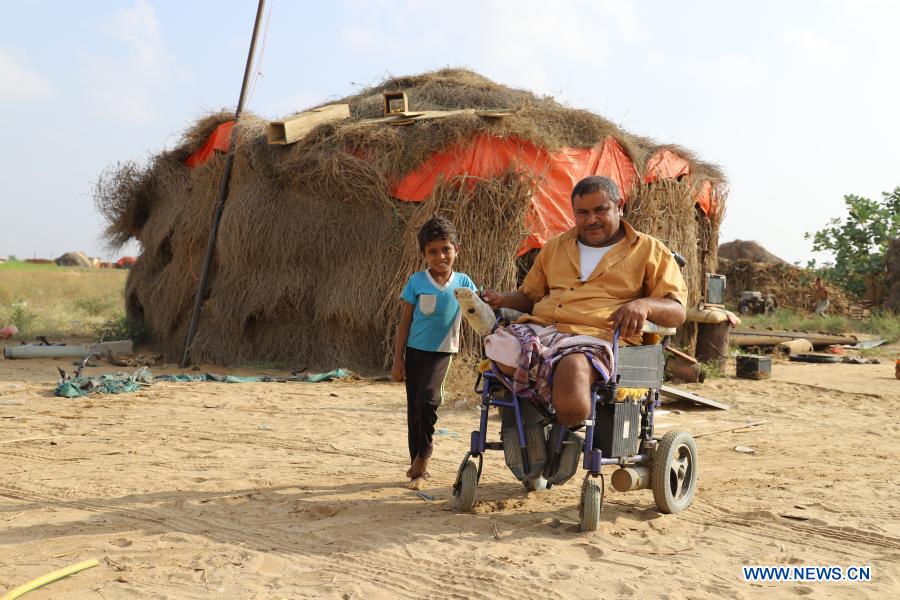
Photo taken on Dec. 19, 2020 shows a landmine victim sitting in a wheelchair with his son in front of their straw hut in Hajjah province, north Yemen. (Photo by Mohammed Al-Wafi/Xinhua)
by Mohamed al-Azaki, Mohammed Al-Wafi
HAJJAH, Yemen, Dec. 20 (Xinhua) -- Khamj Shouei, a car mechanic, is one of the many victims of landmines in Yemen's northern province of Hajjah.
His tragedy began early this year, when he, his wife, and six children decided to return home after spending five years in a displacement camp on the border with Saudi Arabia.
Shouei was planning for a better future, but winds blow counter to what the ships desire.
"I wish I hadn't returned home," the 39-year-old told Xinhua, lamenting his ordeal.
"That decision has completely changed the course of my life. After I returned in February, and while I was inspecting the remains of my house and my workshop which were destroyed by the battles, a landmine exploded under my feet. I lost both of my legs," he said.
In the village of Al-Khadhra, Shouei is now confined to a wheelchair and his plans before the landmine explosion had already vanished.
The government forces recaptured Al-Khadhra and several other neighboring areas in Haradh district from the Houthi rebels in June 2019.
The Houthis had planted tens of thousands of mines before their withdrawal, according to the UN humanitarian agencies' data.
The government-run Saba news agency reported that the army has cleared more than 32,000 landmines in the districts of Haradh, Hayran, Midi and Abs of Hajjah Province since the beginning of 2019.
"Thousands of landmines had been planted in villages, schools, and farms. Clearing these areas of landmines could take years," Yasser al-Rouhani, head of the landmine clearance division in the government forces, told Xinhua.
The Houthis controlled several northern provinces after pushing southward from their stronghold of Saada Province in late 2014, forcing the internationally recognized government of President Abd-Rabbu Mansour Hadi out of the capital Sanaa and triggering an all-out civil war.
A coalition of forces led by Saudi Arabia intervened in the Yemeni conflict in 2015 to support the Yemeni government in pushing the Iran-backed Houthi rebels out of the Red Sea coasts.
A Saudi project is being carried out in Yemen to help the government clear the country of landmines to allow displaced people to return home.
"The project has cleared 204,507 landmines and unexploded ordnance from across Yemen since mid-2018," Osama Al-Gosaibi, the project director in Yemen, told Xinhua.
The United Nations is trying to end the war in Yemen that has killed tens of thousands of people, mostly civilians, displaced 4 million, and pushed over 20 million to the brink of starvation.
The six-year-old war has destroyed Yemen's infrastructure, health, educational and economic institutions, reducing more than 80 percent of the population to destitute dependants on foreign humanitarian aid.
The United Nations describes the humanitarian crisis in Yemen as the worst on the planet, with hunger, acute malnutrition, epidemics, and economic blockade killing thousands of Yemen's children.



